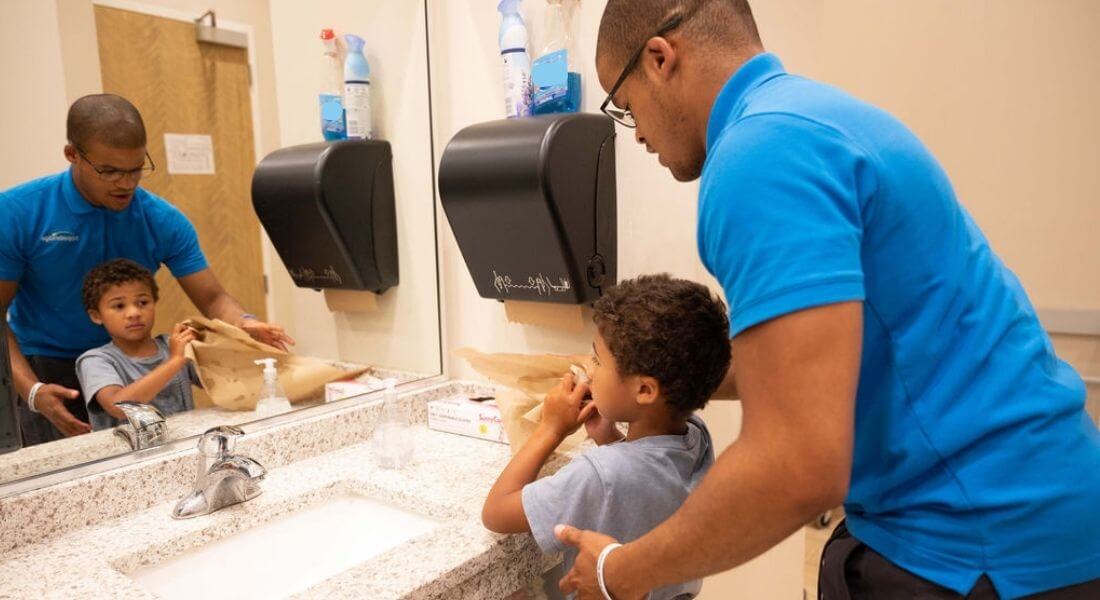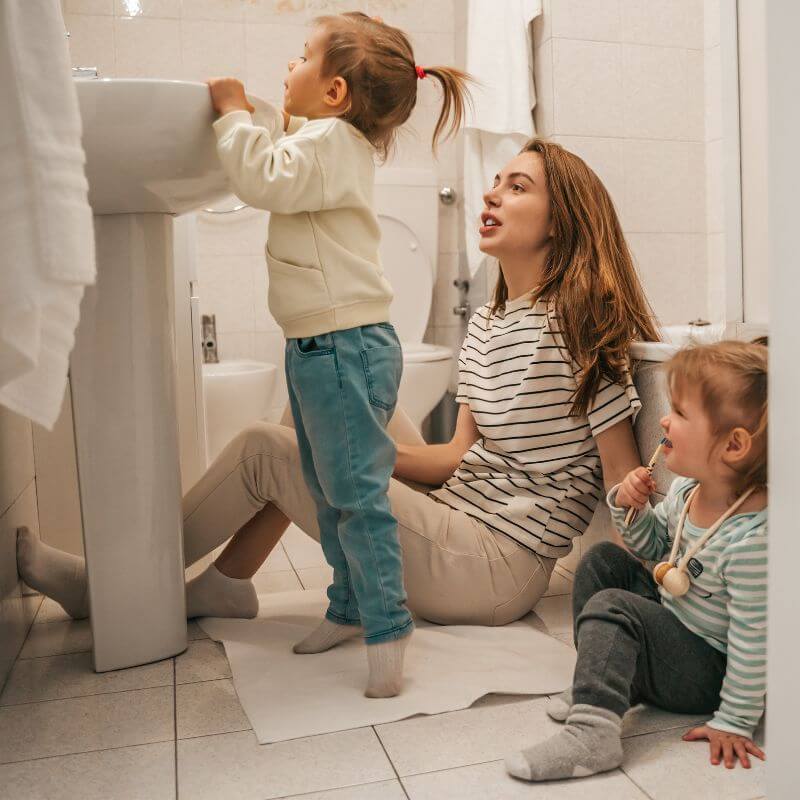How to Support Children with Autism Through the Sick Season
December 01, 2022
December 01, 2022

It’s that time of year: The “is it allergies or is it a cold?” time of year. The germy, missing-school-every-other-week time of year. The time of year when parents feel helpless as their children battle through congestion, coughs and sore tummies.
It is so difficult to watch any of our littles suffer through illnesses, but it can be even tougher for some families touched by autism spectrum disorder (ASD). From challenges in understanding how they feel, to struggles with changes in routine, we know caregivers wish they could do more to shield their kids from these uncomfortable moments.

Though flu season unfortunately doesn’t seem to be going away any time soon, there are ways we can slow the spread and ease its effects on our children.
To help families better prepare for and protect their children from influenza – plus Respiratory Syncytial Virus Infection (RSV); stomach viruses; COVID-19; Hand, Foot and Mouth Disease; and everything in between – we turned to Hopebridge Board Certified Behavior Analyst (BCBA) Kaylee Robinson from our autism therapy center in Conway, Arkansas. As always, we recommend turning to your physician for medical advice, but in the meantime, Kaylee shares how we collaborate with families to approach health and wellness through health-focused measures in our centers, skill development with applied behavior analysis (ABA therapy), and practice at home.
With multiple kids in our centers, along with at least one therapist for every child, it’s impossible to keep germs from sneaking inside. Instead, we focus on what we can do to wash them away.
At Hopebridge, having a cleaning crew visit on a weekly basis has been helpful. Our team tidies throughout the day, but this deep clean is an extra layer of sanitation against bacteria and viruses. We’re always fully stocked with sanitizing wipes and have disinfectant fogging machines that we use during peak sickness times.
Trying to monitor what comes into the center is important, too. When we find out there is a child or staff member with a cold or contagious illness, we have a team on flex support that can deep clean everything and sanitize our toys right away.
A couple weeks ago we had two cases of the flu, but it didn’t spread like I’ve seen it in other environments in the past. This continues to build confidence in our healthy living practices at Hopebridge.

There are several ways we incorporate health and hygiene into autism therapy, and I always ask questions around these topics during my initial ABA evaluation. For instance, “How is your child with washing their hands and brushing their teeth?” This is often where caregivers will tell me whether their child is uncomfortable taking medicine, doesn’t know how to blow their nose, or if it is a challenge every time they need to take them to the dentist or doctor’s office. By getting some more color around these areas up front, I can program and help teach toleration around these specific skills and tasks.
As far as hygiene is concerned, handwashing is typically one of the first things we work on with our children as part of ABA therapy. It’s something they need to do every day, whether sick or not—when their hands get dirty, before meals and after they use the restroom. Some of the other skills, like teeth-brushing and toilet training, are a bit more invasive and can be more challenging to tolerate and taking medicine can be traumatizing if done too quickly, so we want to be careful with how we present them.
To teach kids to wash their hands, I start by modeling the action. If I have to wash my hands, I have them come with me, and if it’s time for them to wash their hands, I also use that time to show them how I do it.
As part of Hopebridge’s trauma-informed care and our focus on the “happy relaxed and engaged” approach, I completely removed full physical prompting from our prompting hierarchies, meaning I do not hold the kids’ hands to wash them. In other places, I’ve seen full physical chaining procedures, but I’ve switched to place efforts on gestures and modeling within chaining, which seems to work wonders because not everyone likes to be touched. As part of our family education sessions, I also like to show parents and caregivers how to do the same.
If children are still working on imitation skills, modeling may not be enough, so partial physical prompts are sometimes necessary. I personally avoid the hand-over-hand approach because I’ve seen pushback from children and want them to feel comfortable and relaxed during the process. It’s part of building trust with them, while teaching them at the same time.
In addition to modeling, I’m a big fan of visuals. Visuals can be adapted to your child’s needs and are something they can use for years to come, if beneficial.
A big goal of ABA is to help these individuals live their most independent lives, and visuals can serve as a helpful reminder throughout life. If a 30-year-old needs to look at a picture to help wash their hands or hang a chore list in their house in order to live independently, there is no reason why they shouldn’t do that.
In general, visiting a doctor’s office can seem a little scary, both for neurodiverse individuals and their neurotypical peers. Add flu shots or blood draws to the mix, and it’s natural for children and adults to feel even more nervous. Thankfully, there are a lot of ABA strategies we can use for desensitization of taking medication and visiting the doctors.
Many times, the fear doesn’t come from the activity itself, but from not knowing what to expect. Being able to give children a good idea of what is coming next can be helpful. We talk to them, show them photos and videos, and make sure the process is as fun and reinforcing as possible. In addition, we also work with them on communication, so they have a way to tell us things like, “I don’t like this” and “this is what scares me …”

At Hopebridge, we have the ability to make our center lobby feel like a pediatrician’s office to work on desensitization skills and toleration leading up to the appointments.
On the big day, it is also beneficial to add in some sort of reward afterward. Knowing something fun is coming later can help many children.
About a year ago, I worked with a family who wanted to have their child vaccinated against Covid, but he would not tolerate it. He received the first shot, but it was not a good experience, so even as they pulled up to the office the next time, he would not go into the building to get the second dose. It was my job to help him feel comfortable for the next time.
To prepare him, I found an educational video that was motivating for this specific child. He loved Daniel Tiger, so I found an episode about Daniel getting a shot that we could watch together.
I also gathered materials like cotton balls, a syringe (with no needle, of course!) and Band-Aids for play. I made them exciting and let him play while watching the video. Then I said, “Now we’re going to pretend to be Daniel Tiger.” If at any point he hesitated, I stepped back and waited until he was more open to it, then would re-present the materials. We got to the point where he tolerated the entire process, even scripting what Daniel Tiger said in the videos.
The best part? He was able to successfully get the second dose of the vaccine because he knew what to expect from the process!
Parents do not always know when a child is going to need a shot, have blood drawn or take medicine, so even if families choose against immunization, these are still helpful skills for children to learn.
View this post on Instagram
We can work on these types of skills and behaviors during therapy but bringing them (hopefully without any germs!) into the home is equally important. To get you through cold season, here are some of my top tips for caregivers:
I’m not a medical doctor, so if a child is experiencing medical symptoms and engaging in high rates of behavior because they are sick, my recommendation will be for them to go to the doctor first. I can’t treat the illness, nor can I work with them to manage the behavior if they are sick.

In the meantime, there are other ways I can help, and there are for you, too. If I’m in the process of calling parents because a child is sick, I do what I can in the moment. That might be giving them something to chew on, accompanying them to sit in the sensory room, or supplying an ice pack. I give them time to work on their feelings, but also open communication opportunities so they know I’m there to help.
In these sick situations, I urge parents to focus on their own patience and understanding. If you or I do not feel good, we can communicate that to get help in most cases, but some of our kids really struggle with this. Take a compassionate approach. Let them know you understand and are not mad at them. The most important thing you can do is let them know you are there for them.
We love working on these types of skills with your children. It is incredible to watch them take on tasks to live more independently, and we hope you will give us the chance to support your child and your family through this journey. If you are interested in learning more about our ABA therapy and interdisciplinary services*, please contact us here. With centers around the country, we have the environments, knowledge, time and experience to help them learn the foundational living skills to set them up for a lifetime.
*Informed consent was obtained from the participants in this article. This information should not be captured and reused without express permission from Hopebridge, LLC. Testimonials are solicited as part of an open casting call process for testimonials from former client caregivers. Hopebridge does not permit clinical employees to solicit or use testimonials about therapeutic services received from current clients (Ethics Code for Behavior Analysts 5.07-5.08; BACB, 2020). Hopebridge does not provide any incentives, compensation, or renumeration for testimonials provided by a former client or client caregiver.
Tips and Advice
March 03, 2020
How to Brush Teeth and Visit the Dentist with a Child with Autism